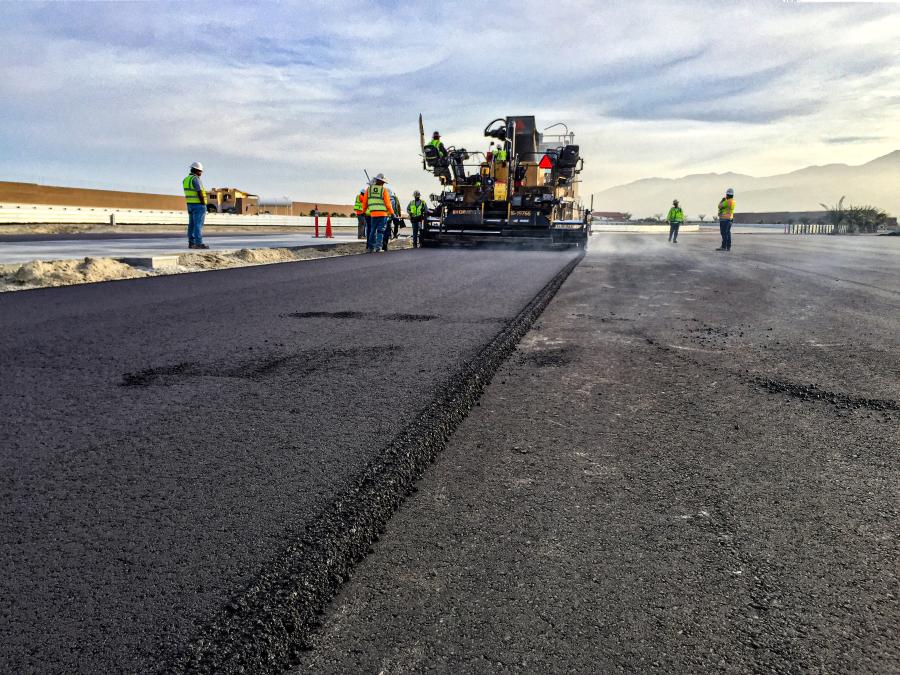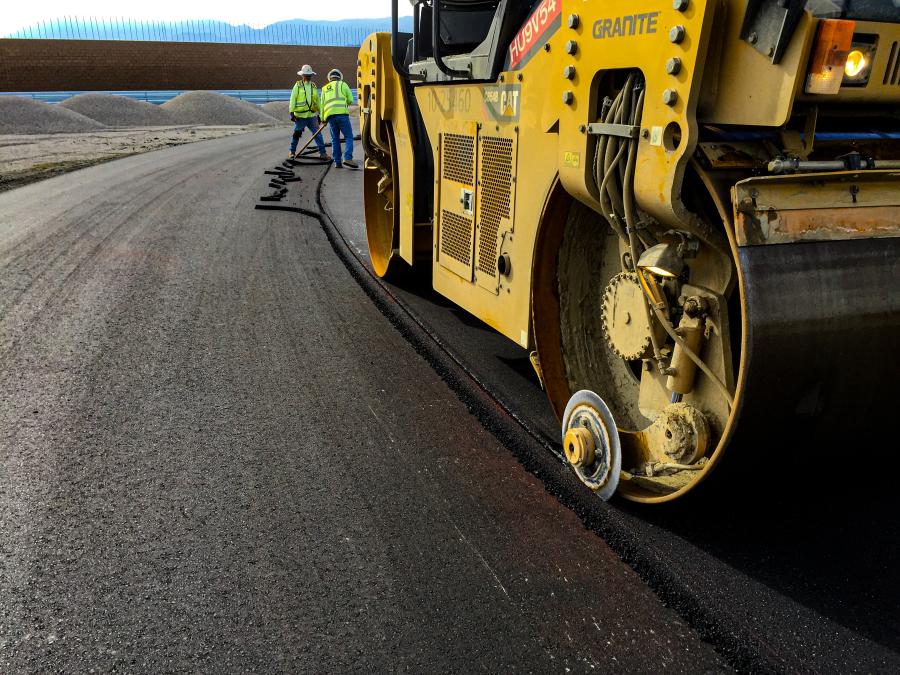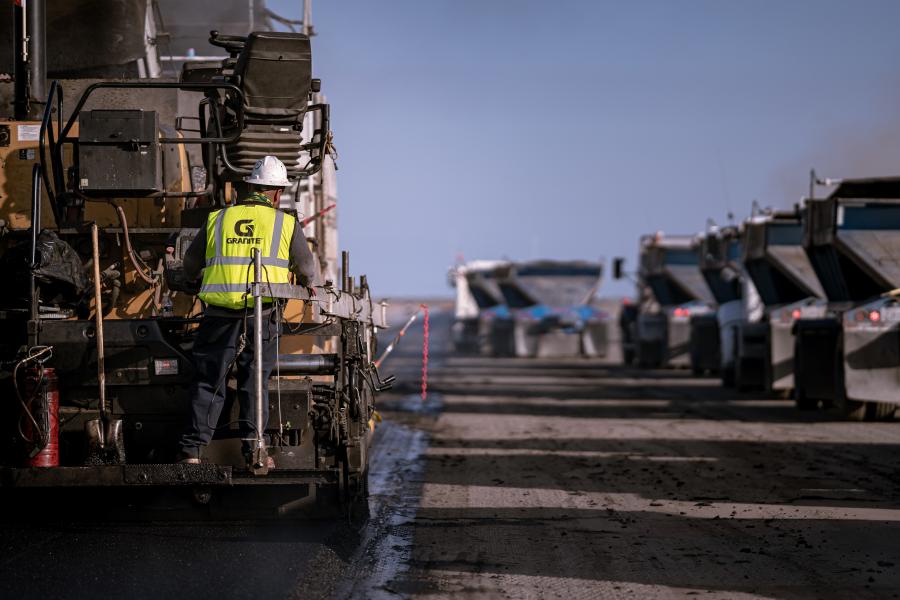The Freeman Gulch Widening Project (FGWP) is converting the existing SR 14 two-lane conventional highway into a four-lane divided controlled access expressway. The project to widen 16.4 mi. of road has been divided into three segments, with the first already completed by Granite Construction.
(Photo courtesy of Granite.)
In an effort to improve the safety, capacity, operation and route continuity on State Route 14 in Kern County, the California Department of Transportation's (Caltrans) Freeman Gulch Widening Project (FGWP) is converting the existing two-lane conventional highway into a four-lane divided controlled access expressway.
The project to widen 16.4 mi. of road, which could carry a cost of up to $170 million, has been divided into three segments, with the first already completed by Granite Construction.
This project will close the final two-lane gap on SR 14 between Mojave and the junction with U.S. 395, according to the project web page.
Planning for Segment 2, which would widen approximately 6.2 mi. from 4.8 mi. south to 0.5 mi. north of SR 178 west, is ongoing.
"Since 1955, Caltrans, in cooperation with its local transportation partner, has worked to four lane the U.S. Highway 395 and State Route 14 corridor" said District 9 Director Brent Green. "This project is yet another important milestone in our goal to achieve this vision."
Caltrans Director Laurie Berman added, "This roadway is the principal access into the Inyo and Mono County recreation areas. This project improves the safety, capacity and operation of this important route for the eastern Sierra region and its economy."
The project partners recognize the need for safety and operational improvements within the segment as the SR 14 Transportation Concept Report identifies a current Level of Service (LOS) of "D."
"Without highway improvements, the LOS will further deteriorate to an unacceptable level," stated the web page. "This project will improve this segment of highway to an LOS of ‘B,' and to a four-lane expressway facility."
Completed Construction So Far
Granite Construction, which has been working on the project for a few years now, started Segment 1, $21.6 million, in May 2017, which widened SR 14 from a 0.5 mi. north of the junction of SR 178 West to 4 mi. north. The project was jointly funded by the Kern Council of Governments, the Inyo and Mono Local Transportation Commissions and Caltrans.
Christian Lukens, Caltrans' District 6 information officer, noted that the work included one bridge (NO. 50-0521) and connector to SR 178.
"The existing lanes were rebuilt with HMA and an RHMA overlay," he said. "They contain both a paved median, and a separated median area."
Segment 1 was designed by Anton Kismetian. Average daily traffic before the work was 5,620 (2018) cars and trucks daily and with the new lanes, the expressway section can handle 6,210 (2038) vehicles.
"The design and engineering challenges included cost, environmental, right-of-way, material sites, drainage and mitigation,"" said Lukens. "The lifespan of the new lanes is 20 years. There were 11 special-status animal and plant species on-site and had the potential to occur within the project area."
The Segment 1 work site was approximately 100 mi. from Granite's closest office/equipment yard.
"It was a project to widen a highway from two lanes to four lanes in a remote area," said Darryl Ebel, Granite's Bakersfield area manager. "Challenges included personnel having to commute and materials such as base rock and asphalt being required to be hauled a long way. The job was in the desert, so a well-developed water supply to compact soils presented a challenge. The area is subject to high winds blowing dust and stored material around, such as pipe. The dirt on the project had a higher shrinkage factor than anticipated, so less material was available to export to Segment 2 than originally anticipated.
"The project was completed on time and on the owner's budget," he added, "The soil had a higher shrinkage factor, so more material was incorporated to build the project embankments and less material was stockpiled and exported for Segment 2. Local water sources along the projects had limited water flow, so we had to bring water further from Inyokern to keep up with operational needs. There were no significant utility issues."
This was primarily a day shift, with very little night work.
"It was a four-mile linear project built in stages," said Ebel. "There may have been ongoing structures work outside an area where staged earthwork was being performed. All work was performed along a continuous four-mile segment of right-of-way.
"The project was set in a very rural area, with a couple of businesses and residences along the ROW — very sparse development over the four miles,"he added. "It was a good job. Good partnering with Caltrans. It was very successful teamwork."
The new lanes were constructed next to the existing road. Granite had three crews operating simultaneously — one dedicated to clearing and grubbing and excavation, another for site prep and installation of underground infrastructure and another that paved the lanes.
"The project was constructed by building the new alignment [lanes] to the east of the existing two-lane segment," said Ebel. "Work proceeded from north to south. Once the new NB lanes were built, traffic was switched there. The new SB lanes were then reconstructed on the old two-lane alignment. Then a final lift of rubberized asphalt paving was constructed and traffic was placed in its final configuration. The project used multiple crews to perform clearing, mass excavation, grading, drainage, structures work and base and paving. There was a plan to build the project in a standard logical sequence — clear, grade, drainage, base, pave — very standard. Earthwork shrinkage, mentioned previously, was the challenge."
Contractor's Equipment
The dirt was moved using Cat 651 scrapers, which was then pushed with D10 push Cats and finished and graded with Cat 14G blades. The blades and finish scrapers had TopCon and Trimble GPS systems.
The site prep work included the installation of underground infrastructure and drainage systems.
"We put in numerous HDPE culverts and one major reinforced concrete box culvert was extended," said Ebel. "Compaction on the backfill of the culverts with native material was challenging. Much was done with slurry. The job took nearly two years to build. The work was built on schedule. It took weeks to perform most operations in each stage —mass excavation, grading and base rock all to get ready for paving."
The reconstruction of the existing lanes followed a similar process.
SR-14 has standard 12-ft. lanes and 10-ft. shoulders.
Excavation operations removed 600,000 cu. yds. of material. In terms of new materials, 6,000 linear ft. of culvert pipe was installed, along with 56,000 cu. yds. of base rock, 70,000 tons of asphalt paving, and 900 cu. yds. of structural concrete in the box culvert, with 200,000 lbs. of reinforcing steel.
"The existing roadway materials were incorporated into the fills on the reconstructed SB alignment," said Ebel." CEG
Irwin Rapoport
A journalist who started his career at a weekly community newspaper, Irwin Rapoport has written about construction and architecture for more than 15 years, as well as a variety of other subjects, such as recycling, environmental issues, business supply chains, property development, pulp and paper, agriculture, solar power and energy, and education. Getting the story right and illustrating the hard work and professionalism that goes into completing road, bridge, and building projects is important to him. A key element of his construction articles is to provide readers with an opportunity to see how general contractors and departments of transportation complete their projects and address challenges so that lessons learned can be shared with a wider audience.
Rapoport has a BA in History and a Minor in Political Science from Concordia University. His hobbies include hiking, birding, cycling, reading, going to concerts and plays, hanging out with friends and family, and architecture. He is keen to one day write an MA thesis on military and economic planning by the Great Powers prior to the start of the First World War.
Read more from Irwin Rapoport here.
Today's top stories
















